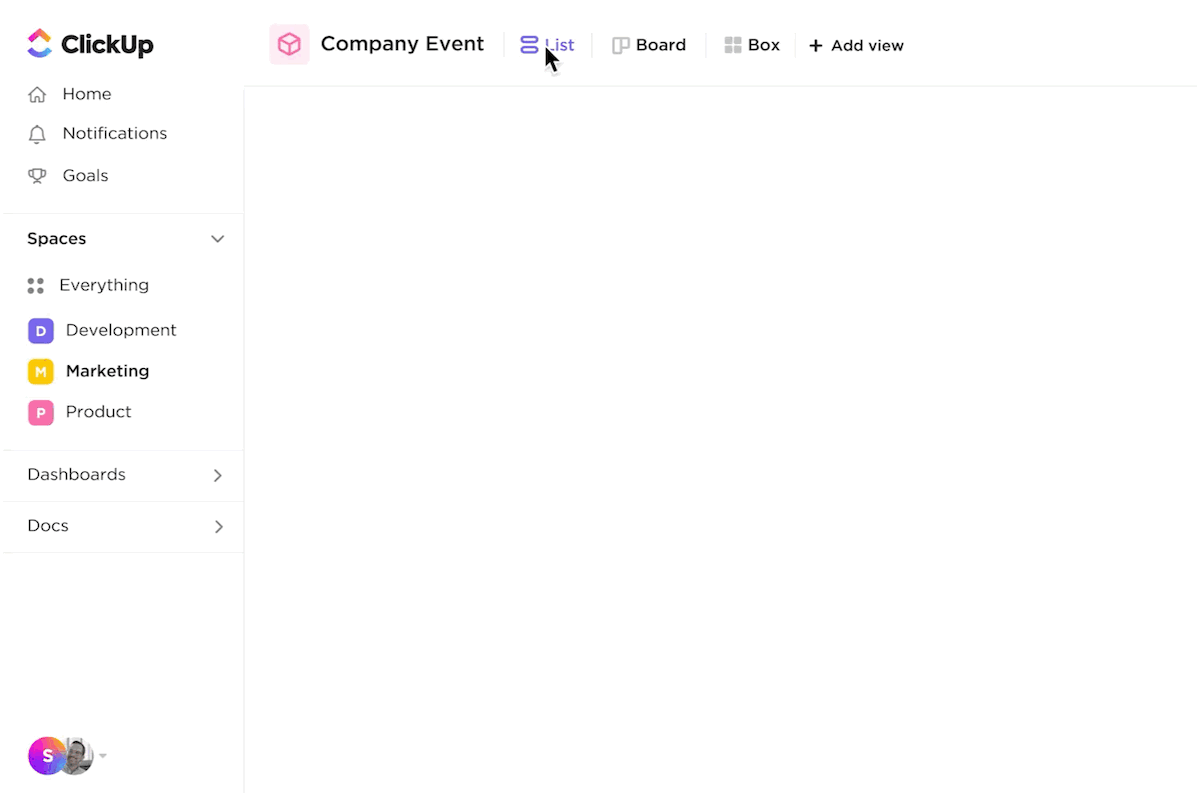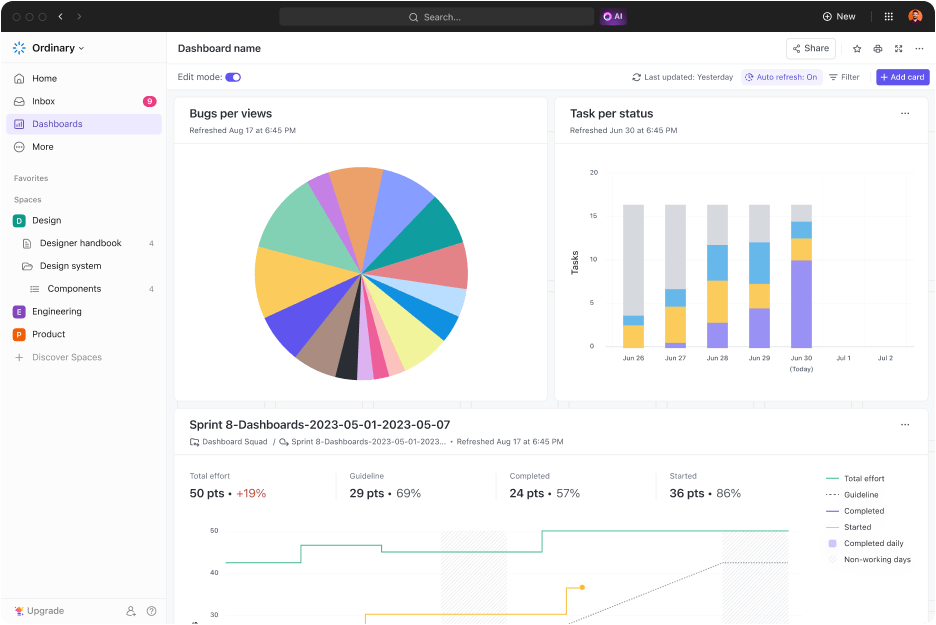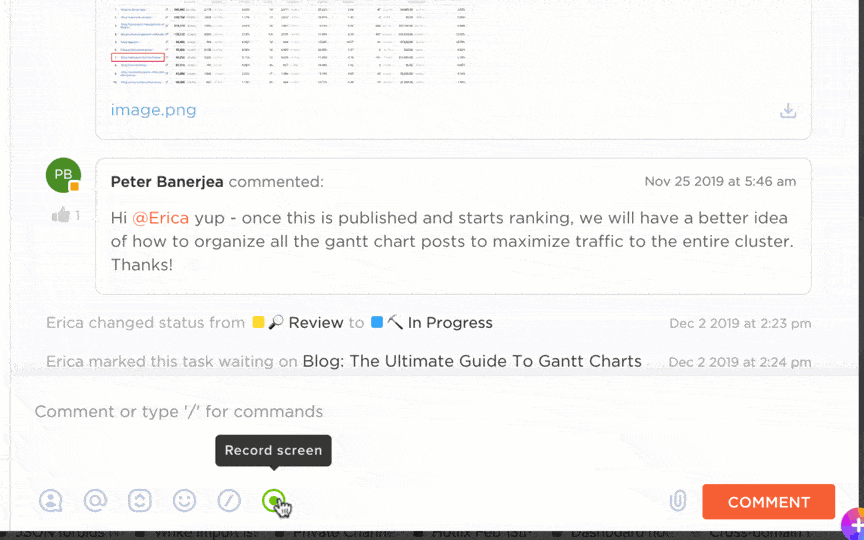

A team isn’t a homogenous group of people—while everyone might be working toward the same goal, each team member takes a unique path to achieving it. Some focus on the big picture, while others concern themselves with the small stuff. Certain teammates thrive in groups, whereas some value solitude and independence.
Whether you want to understand your own professional persona or figure out what makes your team members tick, you’ll find the answers you need by assessing different work styles. This guide will break down the six most prevalent ones to help you learn how to adapt your workflow to accommodate different professional approaches.
What Is a Work Style?
A work style is your dominant approach to your job, specific tasks, and the work environment. It’s determined by a wide range of factors, most notably:
- Personality traits
- Communication style
- Habits
- Beliefs and values
- Past experiences
- Preferences
Your work style impacts just about every aspect of your day-to-day work. It reflects how you organize your tasks, accept feedback, and handle those tough days full of stress and chaos. It also indicates whether you thrive within a team or prefer being a lone wolf. 🐺

While work styles are relatively constant, they’re not set in stone. Your dominant style might evolve over time or change to accommodate specific tasks and projects.
Understanding your style is crucial to maximizing your productivity and the level of enjoyment your work brings you. If you’re a team leader or manager, knowing your team members’ work styles brings about an array of benefits, most notably:
- Effective work delegation
- Streamlined collaboration
- Enhanced inclusivity
- Better team synergy
Six Types of Work Styles
Work styles can be split into six broad categories with their own specific strengths and weaknesses. Below, you’ll see an overview of each, followed by some helpful advice on managing a team with diverse professional approaches. We’ll also share some friendly tips for improving your own work style, so stay tuned! 🤩
1. Logical/Independent
People with a logical work style are avid problem-solvers who value reason and autonomy more than anything. They follow their own compass and have a highly systematic approach to work, analyzing everything down to the tiniest nuances. 🔬
Thanks to their go-getter attitude, logical/independent workers can be trusted to get the job done without slacking off. They don’t need (and often detest) hand-holding, so being micromanaged is one of their worst nightmares. Such people do their best work when you give them the necessary input and set them on their way.
Key strengths of people with a logical style include efficiency, laser-sharp focus, and outstanding critical thinking. They also don’t require much supervision, making them highly reliable and trustworthy.

On the flip side, employees who fall under this category don’t always play nice with others. You likely won’t see “excellent team player” on their resume, and their communication skills could use a bit of work. In some cases, they might also have issues with authority, as they believe it’s their way or the highway.
As long as you give a team member with this work style their freedom and space, you can rest assured knowing the job will be done right.
2. Cooperative
In stark contrast to the previous category of workers, cooperative team members are all about togetherness. You’ll find them brainstorming ideas, helping each other out, and being the first in line for after-work drinks. 🍹
Such people are easy to work with, and their knack for socializing makes them fun to be around. This doesn’t mean it’s all-play, and no work, as they’re highly productive in group projects and can make significant contributions with their ideas.
Some of the best traits of people with a cooperative work style are:
- Open-mindedness and extroversion
- High energy
- Great people skills
The main flaw of cooperative employees is a lack of self-reliance when it comes to important work and decision-making. They might be hesitant to make big moves unless someone is around to discuss the matter, and working alone may lead to unproductive restlessness.
3. Supportive
Team members with a supportive work style share many traits with their cooperative peers, though they’re less conspicuous and assertive. You typically won’t see them at the helm leading the way but below the deck, using their strength and perseverance to keep the ship sailing. ⚓
This doesn’t mean supportive professionals don’t make good managers. On the contrary—they can thrive in organizations that implement the participative management style and motivate the team to bring their A-game.
Supportive work style team members are the backbone of a successful team for the following reasons:
- They’re active listeners and empaths
- They can uplift others and build an atmosphere of trust
- They’re willing to jump in and help out whenever necessary
This last point is a double-edged sword, as it’s also the source of a supportive worker’s biggest troubles. They tend to selflessly overfill their schedule to help others, which can result in exhaustion. Paired with their unwillingness to seek help, this can easily lead to chronic burnout.
Supportive team members also avoid conflicts and often don’t voice their opinions, so good ideas might never see the light of day. That’s why they should be encouraged to speak up and be more confident.
4. Proximity
A proximity work style is characterized by continuous connection. People who adopt it prefer direct face time with others instead of DMs and emails, and they value real-time collaboration over asynchronous arrangements.
Proximity-driven team members are highly adaptable, which is both a blessing and a curse. On one hand, this makes them excellent teammates who work well in different groups and settings, and they embrace change more easily than most.
Still, this flexibility may get out of hand and prevent the team member from developing their own processes and opinions. They might blend into the background too much and fail to provide unique perspectives. 😶
A proximity-focused individual is also highly dependent on instant, ongoing feedback, so they might need more hand-holding than others. That’s why remote work may not be the best choice for them.
5. Detail-oriented
You know that person who triple-checks a report to make sure not a single typo slipped through? Or that spreadsheet lover who can’t wait to teach you about VLOOKUP? Well, that’s the ideal representative of the detail-oriented work style. They always go the extra mile to ensure nothing passes them by, and you’ll hardly find someone better at organizing their workflow. 🤓
With this in mind, it’s no surprise that such individuals thrive as accountants, analysts, and professionals in other positions that require meticulous work. Besides the unparalleled attention to detail, their main strengths include:
- Reliability
- Diligence
- Thoughtfulness
As for the downsides, it’s not uncommon for detail-oriented people to lose sight of the end goal. They might get bogged down in details to the point at which it becomes obsessive, which can significantly slow them down.
6. Idea-oriented
Every team needs a visionary who will dream bigger than others, otherwise known as an idea-oriented team member. Unlike those from the previous category, they don’t sweat the little things or care about a problem’s details—they just want to find an innovative way of solving it. 💡

Naturally, the idea-oriented work style rules brainstorming sessions and is highly receptive to others’ perspectives and feedback. They’re your go-to when you hit a brick wall, as they’ll find a way to tear it down. The key advantages of such employees are:
- Creativity and outstanding imagination
- Ambition and optimism
- A can-do attitude
Now, constant out-of-the-box thinking makes idea-oriented people highly unstructured. They love their creative chaos, which can sometimes be too much to handle. Such employees might struggle to stick to the schedule or project budget, which can result in many complications.
How to Manage a Team with Various Work Styles
One of your main duties as a manager is to understand your team’s work styles and adapt to them. This is no easy feat, so let us share some useful tips that can make a world of difference. 🏆
1. Use the right tools for each work style
Whether your team is on-site or fully remote, you likely use various tools for people and project management, from scheduling apps to productivity trackers. But are those tools adaptable enough to account for different work styles?
If not, you need a versatile solution that will accommodate all of the aforementioned specifics. In other words, you need a tool like ClickUp. It offers a comprehensive suite of project management features that help you get the most out of each team member and keep them engaged.
Thanks to various ClickUp views, you can present information in different ways that suit employees’ specific work styles. Use mind maps and timelines to map out processes for visual thinkers, or switch to lists or tables for those who prefer simpler structures.
ClickUp also offers the flexibility to give each team member the exact amount of input they need. Use ClickUp Clip to provide an independent employee a quick run-through of their task using a screen recording, and leave them to do their best work.

For cooperative and idea-oriented team members, ClickUp Whiteboards is a perfect solution. It fosters teamwork and big-picture thinking, letting everyone stay on the same page. And for the detail-oriented folks, ClickUp Docs offers unlimited freedom to dive deep and create robust SOPs that don’t leave anything out. Whether you need to outline a small one-off project or an entire business plan, ClickUp Docs can be an excellent companion.

Finally, supportive and proximity-driven team members will appreciate assigned comments—an easy way to create action items while collaborating in real time. No matter which work styles are dominant in your team, there’s a ClickUp feature for everyone! 🙌
2. Adapt your communication to different work styles
If you want to get the most out of a diverse team, you’ll need to let go of outdated practices like fixed performance reviews or uniform meetings. Instead, you should adopt a more flexible approach that accounts for specific work styles, particularly in relation to communication preferences. 🗣️
For instance, proximity-driven employees will appreciate daily standups or other frequent check-ins, while independent team members might not need more than one meeting per month.
Similarly, detail-oriented people typically prefer a fixed meeting cadence with predetermined dates, while idea-oriented ones don’t mind a more lenient approach. The former also value data-driven feedback and input, while the latter are happy to chit-chat and brainstorm.
If you’re not sure how to approach each employee according to their work style, the best thing you can do is also the simplest—ask. Encourage team members to communicate their preferences, and they’ll appreciate being heard.
3. Match tasks with strengths
One of the main reasons to familiarize yourself with your team’s work styles is to use this knowledge when delegating tasks. Otherwise, you might waste someone’s talent on work that doesn’t suit them. Like Einstein said, “If you judge a fish by its ability to climb a tree, it will live its whole life believing that it is stupid.”
The good news is that once you’ve figured out everyone’s work style, assigning the right tasks to each team member shouldn’t be a problem. If there’s some heavy data crunching, you’ll know it should go to a detail-oriented person instead of an idea-oriented one. If a project has many moving parts and dependencies, you’ll want to involve cooperative employees and find a standalone task for an independent one.
Now, this match-making might not be easy, especially at the beginning, before you’ve solidified certain workflows. If you need help staying on top of your team’s workload, ClickUp Tasks can do wonders for keeping everything neatly organized.
Thanks to over 35 versatile ClickApps, you can use ClickUp Tasks for everything from daily planning to big-picture operations strategies. Set up tasks with custom statuses, dependencies, and checklists to keep everyone on the same page and ensure seamless collaboration.

ClickUp also comes with tons of Automations and handy features like recurring tasks, which let you avoid mundane work and free up more time for optimizing your workflow according to different working styles.
How to Improve Your Work Style
Understanding your personal work style isn’t only about playing to your strengths. As you saw, each approach comes with specific shortcomings that you can address to take your professional self to the next level. While the particular steps to doing so vary between styles, here are two universal tips to follow.
1. Observe your workday
If you’ve been doing the same job for a while, it’s natural to switch on the autopilot mode at some point. This makes it hard to notice any areas for improvement, so take a step back to assess your workday mindfully.
As you do, focus on the things that you might find annoying, unnecessary, or overwhelming. For example, you may realize you don’t need as many touchpoints with your team leader or that you’re finding it hard to prioritize your work.
Once you’ve identified these pain points, see what you can do independently to fix them. For example, you can use ClickUp Task Priorities to organize your workload or ClickUp Goals for a visual overview of your progress. 📈

Experiment with different tactics for fine-tuning your workflow according to your preferred style. You’d be surprised by the massive difference a few small tweaks can make!
2. Talk to your higher-ups
You may not have complete freedom to tailor work to your preferred style. Some processes are a matter of company policies or management’s decisions you must comply with until you get a green light to change anything.
That’s why it’s important to discuss your own working style with your team leader and other decision-makers. Don’t hesitate to voice your concerns or suggest a change of course. After all, the change might benefit the entire team, so your manager should be open to implementing it.
If you feel like your skillset and approach to work can be put to better use, see what can be done to accommodate this. You’ll be happier and more productive, so you can focus on doing your best work. 🌟
Create a Potent Synergy
If you’re in charge of a team with diverse work styles, you have an opportunity to create a tight workflow where everyone complements one another. Mixing and matching tasks with strengths lets each team member shine while minimizing the risk of inefficiencies and burnout.
By throwing a capable project management platform like ClickUp into the mix, you can rest assured you won’t get lost in all the working style specifics and processes. Create a ClickUp account, and let’s turn your team into A-players! 🥇



